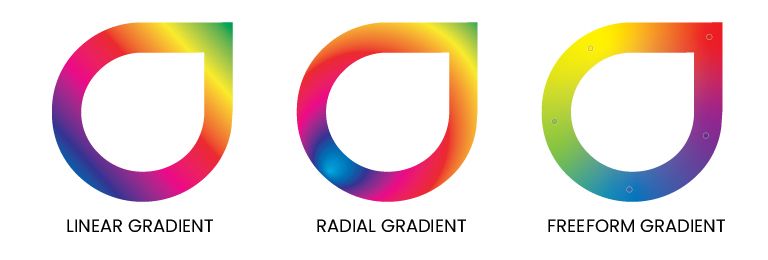

Creative Suite vs. Creative Cloud
Im Mai 2013 löste die Adobe Creative Cloud die Creative Suite ab und hat sich seither als Marktführer in allen Bereichen des Grafikdesigns behauptet. Heute umfasst Creative Cloud 25 verschiedene Anwendungen für die Bildbearbeitung (Raster & Vektor) und die Erstellung von Animationen. Zwei der am häufigsten verwendeten Anwendungen sind Photoshop und Illustrator. In diesem Artikel werden wir ihre Versionen in CS- und CC-Paketen vergleichen.
Photoshop
In der Vergangenheit gab es viele Versionen mit kleinen Verbesserungen, um den Designern die Verarbeitung von Bildern zu erleichtern. Die Wendepunkte traten beim Start der Adobe Creative Suite (CS) und später der Creative Cloud (CC) auf. Im Folgenden werden wir uns auf die Unterschiede zwischen CS- und CC-Versionen konzentrieren.
Im Gegensatz zur CS-Version können Sie in der CC-Version eine Anwendung auf allen Geräten nutzen, vom Desktop bis zum Mobilgerät. Um diese Vorteile nutzen zu können, müssen Sie Ihr Cloud-Konto erstellen. Wenn das Design in der Cloud gespeichert wurde, können Sie fast sofort Änderungen auf Ihrem Tablett oder Smartphone sehen und von dort aus Ihre Arbeit fortsetzen. Im CC sind alle Anwendungen eng miteinander integriert. Durch diese Vernetzung ist die Aktualisierung der Elemente schneller als in CS und damit die Produktivität höher. Wenn Sie einige Änderungen am intelligenten Objekt (in der Regel ein Vektorelement) vornehmen müssen, wird mit dem Doppelklick auf die Ebene das aktuelle Objekt in Illustrator geöffnet. Nachdem Sie Ihre Arbeit beendet haben, werden die Änderungen am Smart Object in Photoshop automatisch aktualisiert. Die CS-Versionen von Photoshop bieten eine einfache Bildbearbeitung. Dies war mit grundlegenden Werkzeugen wie Malen, Auswählen, Zuschneiden, Transformieren, Verschieben, etc. möglich. Photoshop CC ist eine vollwertige Software mit aktualisierten Basiswerkzeugen und neuen Werkzeugen, wie z.B.:
- intelligentes Upsampling
- Kamera-RAW (erweitertes Bildformat mit weiteren Informationen) Bearbeitung
- Schüttelreduktion
- Bibliothek mit über 1000 Bürsten mit besserer Werkzeuganordnung
- Krümmungsstiftwerkzeug zur Vereinfachung der Pfaderstellung
- 360-Grad-Panorama-Workflow
- Glättungskontrolle von Pinsel, Radiergummi und Bleistiftwerkzeug (von 0 bis 100)
- verschiedene Schattenstile für eine Schicht
- Live-Vorschau der Mischmodi
- Präferenz zur Vergrößerung der Schriftgröße der Benutzeroberfläche, um mehr Kontrolle bei der Skalierung der Benutzeroberfläche zu erhalten.
- Textbearbeitung mit Doppelklick
Neben diesen Werkzeugen verfügt Photoshop CC über einen erstaunlichen Arbeitsbereich, der die Arbeit erheblich beschleunigt und vereinfacht. Nach dem Start der Anwendung sind die Schaltflächen zum Erstellen oder Öffnen eines Dokuments in den Arbeitsbereich integriert und gut sichtbar. In der CS-Version dauerte es einige Klicks, bis ein neues Dokument erstellt wurde. Außerdem können Sie das Thema des Arbeitsbereichs ändern (dunkel, dunkelgrau, grau oder hell), einige Gruppenwerkzeuge aktivieren oder deaktivieren und kürzlich geöffnete Dokumente anzeigen. Die folgende Tabelle zeigt die wesentlichen Unterschiede zwischen CS- und CC-Version.
| Photoshop Creative Suite | Photoshop Creative Cloud |
|---|---|
| Verfügbar für Windows- und Mac-Geräte | Verfügbar auf allen Geräten |
| Viele "verschiedene" Versionen mit kleinen Upgrades | Eine Version mit häufigen Updates (letzte aktualisierte Version ist CC 2019) |
| Einfacher Arbeitsbereich | Benutzerfreundlicher Arbeitsplatz für schnelleres und angenehmeres Arbeiten |
| Verschiedene Ebeneneinstellungen werden nicht unterstützt (z.B. mehrfacher Schattenstil oder Copy-Paste-Ebene). | Unterstützung für alle Arten von Layer-Einstellungen |
| Bilder können nicht direkt auf Social Media geteilt werden. | Teilen Sie Ihre Arbeit direkt auf Social-Media |
| Einfache Bildbearbeitung | Erweiterte Bildbearbeitung |
| Keine Integration mit anderen Paketanwendungen vorhanden | Integration mit allen Anwendungen aus dem Paket |
| Grundlegende Werkzeuge für die elementare Bearbeitung: Zuschneidewerkzeug, Verschiebewerkzeug, Schnellauswahl-Werkzeug, Radiergummi, Bleistiftwerkzeug | Erweiterte Werkzeuge für die Bearbeitung: intelligentes Up-Sampling, Kamera-RAW-Bearbeitung, Verwacklungsreduzierung, verbesserte alle Basiswerkzeuge |
| Es kann nur ein Schattenstil für eine Ebene verwendet werden | Zehn verschiedene Schattenstile für eine Schicht |
| Freiform-Stiftwerkzeug für Zeichenpfade | Krümmungsstiftwerkzeug (wie im Adobe Illustrator) |
| Unterstützt das grundlegende Bürstenwerkzeug | Bibliothek mit über 1000 Bürsten |
| Der Benutzer kann die Glätte in einigen Werkzeugen nicht kontrollieren. | Der Benutzer kann die Glätte des Pinsels, des Bleistifts und des Radiergummis steuern (von 0 bis 100). |
| Smart Object einbinden | AErweiterte Operationen mit Smart Object. |
| - | 360-Grad-Panorama-Workflow |
| - | Verwendung von Smart Guides |
| Grundlegende Maskierungsoptionen | Rahmenwerkzeug für einfaches Maskieren |
| - | Textbearbeitung mit Doppelklick |
| Basisoption des Mischmodus ohne Vorschau | Live-Vorschau der Mischmodi mit erweiterten Optionen |
| - | Einstellungen zur Vergrößerung der Benutzeroberfläche (dünn, klein, mittel und groß) |
Das Fazit: Photoshop CC ist eine Anwendung, die professionelle Funktionen zur Bildbearbeitung bietet. Mit ihm kann jede einfache oder komplizierte Aufgabe auf qualitativ hochwertige Weise erfüllt werden.
Illustrator
Illustrator CC ist derzeit Marktführer in der Bearbeitung der Vektorgrafiken. Mit dieser Anwendung können Sie aus Vektorelementen erstaunliches Design erstellen, diese miteinander oder mit Rastergrafiken kombinieren. Wie das Photoshop CC verfügt auch Illustrator über den gleichen Arbeitsbereich mit zusätzlichem Bereich zum Erstellen häufig verwendeter Dokumente (siehe Abbildung unten), grundlegenden Elementen im Arbeitsbereich und einer engen Integration mit anderen CC-Anwendungen. Alle Einstellungen für das Adobe CC-Paket sind in allen Anwendungen gleich.

Unter sorgfältiger Berücksichtigung der Markt- und Benutzerbedürfnisse verbesserte Adobe mit jeder neuen Version die Zugänglichkeit, erweiterte bestehende und entwickelte neue Funktionen wie:
- Präsentationsmodus
- Vorschau der Ist-Größe
- erweiterte Exportoptionen mit einer erhöhten Anzahl möglicher Dateierweiterungen
- skalierbare Benutzeroberfläche
- Unterstützung für südostasiatische Schriftsysteme
- Marionetten-Kettverbesserung (Sie können Teile Ihres Artworks verdrehen und verzerren)
Außerdem haben sie auch die Schriftart verbessert. Mit erweiterten Schriftartenaktionen wie Schriftvorschau, Suche nach einer ähnlichen Schriftart, Schriftklassifizierung und Anzeige der aktuellen Schriftart können Sie ganz einfach die beste Schriftart für Ihre Arbeit auswählen.
Wenn Sie ein Büroset branden müssen und das Logo auf jedem Teil des Sets ändern müssen, können Sie das schnell und einfach tun. Alle Objekte einzeln manuell zu bearbeiten, kann schwierig und fehleranfällig sein. Mit dem neuen Tool "Globale Bearbeitung" können Sie alle gleichen Elemente in nur einem Schritt global bearbeiten (verschieben, löschen, ändern, etc.).

Die letzte Verbesserung, die wir Ihnen in diesem Artikel zeigen wollen, ist die neue Gradientenoption "Freiform Gradient". In der vorherigen Version konnten Sie nur lineare oder radiale Gradienten auf das Vektorobjekt anwenden. Nun können Sie den Freiformgradienten verwenden, um eine abgestufte Mischung von Farbpunkten innerhalb einer auf dem Bild unten dargestellten Form zu erzeugen.

Die folgende Tabelle fasst die wichtigsten Unterschiede zwischen Illustrator CS und Illustrator CC zusammen.
| Illustrator Creative Suite | Illustrator Creative Cloud |
|---|---|
| Verfügbar für Windows- und Mac-Geräte | Verfügbar auf allen Geräten |
| Viele "verschiedene" Versionen mit kleinen Upgrades | Eine Version mit häufigen Updates (letzte aktualisierte Version ist CC 2019) |
| Einfacher Arbeitsbereich | Benutzerfreundlicher Arbeitsplatz für schnelleres und angenehmeres Arbeiten |
| Elementare Werkzeuge zum Zeichnen von Vektorgrafiken | Fortschrittliche Tools mit neuen Funktionen |
| Lineare und radiale Gradienten | Linearer, radialer und Freiformgradient |
| Nur ein Objekt bearbeiten | Globale Bearbeitung eines einzigen Objekts |
| Schriftvorschau ist verfügbar | Erweiterte Schriftartenfunktionen, wie z.B. Suche nach ähnlicher Schriftart, Schriftklassifizierung & Anzeige der aktuellen Schriftart |
| - | Präsentationsmodus |
| Verwenden von Richtlinien und Rastern für präziseres Arbeiten | Intelligente Richtlinien, Ein-/Ausblenden von Richtlinien und Rastern |
| - | Skalierbare Benutzeroberfläche |
| Grundlegende Ansichtsgröße der Dokumentenvorschau | Vorschau der aktuellen Größe (A4) |
| Grundlegende Warp-Objekt- und Textoptionen | Verbesserung der Marionetten-Kette |
| Grundlegender Startbildschirm mit einigen Optionen (Erstellen, Öffnen, Schließen) | Schneller Zugriff auf aktuelle Dateien, benutzerfreundliche, erweiterte Optionen für die Erstellung neuer Dokumente |
| - | Unterstützung für südostasiatische Schriftsysteme |
| Grundlegende Exportfunktionen | Erweiterte Exportmöglichkeiten |
Genauso wie Photoshop CC liefert Illustrator professionelle Ergebnisse in Vektorgrafiken. Mit ihm können Sie erstaunliche Vektorelemente erstellen, die es Ihnen in Kombination mit Rastergrafiken ermöglichen, sich im Bereich des Grafikdesigns hoch zu positionieren.
Nachteile von Adobe CC
Mit vielen der oben genannten Vorteile können Sie erstaunliche Dinge tun, aber es gibt auch einige Nachteile. Erstens ist die Benutzeroberfläche für Anfänger schwer zu verstehen, d.h. sie hat eine steile Lernkurve. Wenn du ein Anfänger bist, gibt es zwei Möglichkeiten: Beginne mit dem Lernen durch einen Kurs oder beginne deine Reise mit einer niedrigeren Version (weniger komplex und schwierig). Adobe CC ist ein umfangreiches Anwendungspaket und erfordert eine gut ausgestattete Maschine. Dieses Problem tritt normalerweise auf, wenn wir qualitativ hochwertige Grafiken rendern wollen.
Für CS und ältere Versionen kaufen Sie die Lizenz nur einmal und verwenden sie für einen unbegrenzten Zeitraum. Für die CC-Version müssen Sie ein Monats- oder Jahresabonnement für das gesamte Paket oder nur eine Anwendung bezahlen. Dies kann für Anfänger und Freiberufler ein Kostenproblem sein, da das Abonnementmodell teurer ist, aber Sie haben immer die aktuellste Version der Anwendungen. Bis Sie lernen, die grundlegenden Funktionen zu nutzen und sich mit der Benutzeroberfläche der Anwendung vertraut zu machen, sind wir der Meinung, dass die beste Lösung darin besteht, mit CS oder älteren Versionen von Adobe-Anwendungen zu beginnen.
Neben den oben genannten Nachteilen gibt es auch einige weniger wichtige:
- Rohe Updates werden manchmal veröffentlicht.
- Die Überwachungsfunktion ist in einigen Tools nicht vorhanden.
- Nicht genutzte volle Funktionalität für jeden Benutzer
Fazit
Wenn Sie in Ihrer Fachkompetenz an der Spitze stehen wollen, müssen Sie Trends folgen und ständig neue Funktionen kennenlernen, die Adobe veröffentlicht. Das Adobe CC-Paket ist marktführend und bietet eine Komplettlösung für jede Designaufgabe. Wenn Sie Anfänger sind, beginnen Sie mit dem Lernen in einigen Kursen oder verwenden Sie ältere Versionen wie CS, die weniger Anforderungen an bereits vorhandene Kenntnisse im Bereich Grafikdesign stellen.
Wenn Sie weitere Fragen oder Anmerkungen haben, kontaktieren Sie uns bitte.